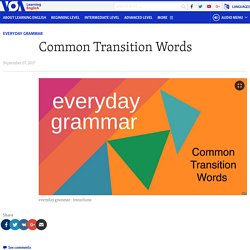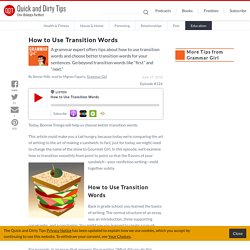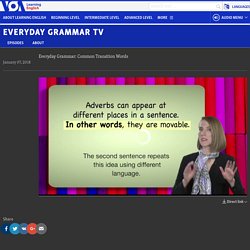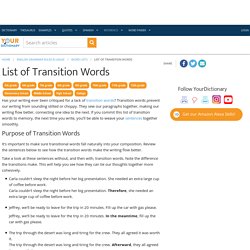

Transition Words. Complete List of Transition Words. Once you have completed the first draft of your paper, you will need to rewrite some of the introductory sentences at the beginning and the transition statements at the end of every paragraph. Transitions, which connect one idea to the next, may seem challenging at first, but they get easier once you consider the many possible methods for linking paragraphs together—even if they seem to be unrelated. Transition words and phrases can help your paper move along, smoothly gliding from one topic to the next. If you have trouble thinking of a way to connect your paragraphs, consider a few of these 100 top transitions as inspiration.
The type of transition words or phrases you use depends on the category of transition you need, as explained below. Additive Transitions An example of additive transitions used in a sentence would be: Adversative Transitions Adversative transitions are used to signal conflict, contradiction, concession, and dismissal, says Michigan State University.
Boundless Communications. Writing 250 – Writing & Rhetoric Advanced Composition. Writing 250 – Writing & Rhetoric Advanced Composition. Common Transition Words. In 1963, President John Kennedy gave a famous speech at American University.

In the speech, Kennedy said the following lines: "Our problems are manmade; therefore, they can be solved by man. And man can be as big as he wants. No problem of human destiny is beyond human beings. " Today's report is not about global problems. What are transitions? Transitions are words that show relationships between ideas. These transition words have different uses. . #1 Expressing a result Transition words that show a result include therefore and thus. The words you heard at the beginning of this report give you one example of therefore: "Our problems are manmade; therefore, they can be solved by man. " In the quote, the word therefore connects two statements: "Our problems are manmade" and "they [our problems] can be solved by mankind.
" The word therefore suggests "for that reason" or "because of that... " Thus has a similar meaning. . #2 Restating or clarifying an idea I.e. can also restate or clarify an idea. Everyday Grammar: Make Your Writing Smoother with Transitions. How to Use Transition Words. Today, Bonnie Trenga will help us choose better transition words.

This article could make you a tad hungry, because today we’re comparing the art of writing to the art of making a sandwich. In fact, just for today, we might need to change the name of the show to Gourmet Girl. In this episode, we’ll examine how to transition smoothly from point to point so that the flavors of your sandwich— Transitional Word Lists for Students. Good writing makes it easy for the reader to understand your ideas.

Explaining a complicated subject involves more than just writing a series of sentences. You also need to show the reader how each idea is related to the next one so they can follow your logic. Connecting one thought to another is often done with the help of transition words. Transitional words and phrases link ideas to each other in a sentence. They can also connect sentences and paragraphs to each other in a logical order.
Transitional Word Lists. Everyday Grammar: Common Transition Words. Accessibility links Languages VOA Learning English PreviousNext Breaking News Live Everyday Grammar TV Everyday Grammar: Common Transition Words January 07, 2018 Embed The code has been copied to your clipboard.

The URL has been copied to your clipboard No media source currently available Direct link. How Do I Include Transition Words in My Essay? Commas with Transition Words. Two weeks ago, we talked about comma splices—errors that happen when you join two main clauses with just a comma--but you can make the same kind of mistake if you aren’t careful when joining two main clauses with conjunctive adverbs such as however, therefore, furthermore, and nevertheless. Two Main Clauses Remember, a main clause, also known as an independent clause, is just something that could be a complete sentence if it were all by itself. If you’re joining two main clauses with a conjunctive adverb, you need a semicolon before that adverb, and a comma after. That adverb needs to be snuggled between a semicolon and a comma. As an Amazon Associate and a Bookshop.org Affiliate, QDT earns from qualifying purchases.
Think about this example. I’m not finished reading it; moreover, I left it at Steve’s house. I’m not finished reading it is a main clause, and I left it at Steve’s house is a main clause, so I need a semicolon before moreover and a comma after it. List of Transition Words. Has your writing ever been critiqued for a lack of transition words?

Transition words prevent our writing from sounding stilted or choppy. They sew our paragraphs together, making our writing flow better, connecting one idea to the next. If you commit this list of transition words to memory, the next time you write, you'll be able to weave your sentences together smoothly. Purpose of Transition Words It's important to make sure transitional words fall naturally into your composition. Take a look at these sentences without, and then with, transition words. Carla couldn't sleep the night before her big presentation.